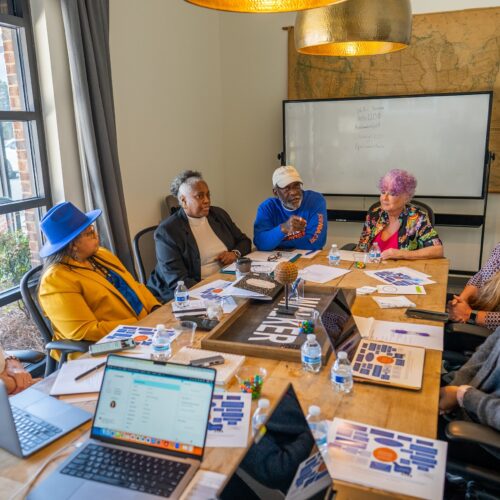
Tips for Engaging Caregivers of Children with Incarcerated Parents in Reentry Programming
For the millions of children who have a parent in prison or jail, being separated from their parent during incarceration is traumatic and can have long-term effects on their development and well-being. As a result, many corrections departments and facilities are creating more child-friendly environments, producing informational materials for families, and implementing policies and programs that center children of people who are incarcerated. These efforts can benefit everyone, according to studies that have linked family contact to improved mental health for the person who is incarcerated and their family members, reduced prison misconduct and recidivism for the person who is incarcerated, and stronger family ties after release.
To increase engagement in these initiatives, agencies can use strategies to focus on the needs and concerns of the children’s caregivers, who are typically the child’s other parent, a grandparent, or other family member. These caregivers often serve as a bridge between the incarcerated parent and the child while trying to meet their own needs. Many caregivers must deal with the loss of emotional support and financial stability as a result of the incarceration and the prospect of parenting alone. Additionally, many have to pay for phone calls and transportation to correctional facilities, expenses that cause many families to fall into debt.
Below are tips and considerations drawn from a presentation and group discussion led by Ann Adalist-Estrin, director of the National Resource Center on Children and Families of the Incarcerated (NRCCFI) at Rutgers University in Camden, NJ. The session was part of a series of learning communities that The Council of State Governments (CSG) Justice Center and the U.S. Department of Juvenile Justice and Delinquency Prevention (OJJDP) hosted with Second Chance Act (SCA) Addressing the Needs of Incarcerated Parents and Their Minor Children grantees.
1. Engage caregivers as subject matter experts, from program development and implementation to ongoing case planning.
Caregivers can provide valuable insight on ways to shape programs to increase participation. Including caregivers in program planning and implementation can give them a rare forum to share their experiences and help ensure that the program responds to their specific needs from the outset. This may involve inviting caregivers to participate in advisory groups or organizing focus groups of caregivers across different communities and geographic areas to gain insight into the diversity of their experiences.
Staff should also ask caregivers what they and their children need, keep them informed, and solicit their input throughout program implementation. This approach can include conducting assessments that are designed to gather information about their needs and potential obstacles to program participation, issuing family impact surveys, and having caregivers participate in regular case planning meetings.
Throughout these processes, staff should be upfront about limitations and explain what can and can’t be done due to safety protocols or other policies. This transparency can help avoid confusion and frustration. If a caregiver offers an idea that is not feasible, staff should engage them in finding creative solutions that address the heart of their request within the parameters of the policies.
2. Acknowledge caregivers’ experiences and concerns.
Caregivers often report that their feelings and perspectives are not heard when they are interacting with program staff or participating in program activities.
When working with caregivers, staff should be mindful that they may be distrustful of corrections agencies and programming. They may also be angry at the person who is incarcerated or resistant to supporting them or their relationship with their child. While program staff often appeal to caregivers by framing their focus as “in the best interest of the child,” caregivers may have views of the child’s best interest that are different from the service providers and from the incarcerated parent. Staff should examine unconscious assumptions and biases that may be informing program decisions and models.
Having transparent protocols and setting standards for discussions that value the perspectives of caregivers, including a statement about the importance of varied points of view, can mitigate some of the distrust. Additionally, being patient is key, and staff should continue to reach out, offer resources, and invite caregivers’ input to build trust over time.
3. Offer practical resources and tangible support.
Caregivers may be more able and willing to participate in programs if given resources and forms of support that help them care for the child. These resources can range from necessary items such as diapers to virtual or in-person groups that allow caregivers to connect with other caregivers as a source of support and additional information.
Corrections agencies can also dedicate space on their websites for information and resources that are useful to caregivers. This can include developing new materials, such as guides to help them prepare for visits and respond to children’s questions and concerns as they cope with their parent’s incarceration.
Additionally, offering accommodations, such as flexible schedules and alternative forms of communication (e.g., texting instead of calling or emailing), can make it easier for the caregiver and the child to be part of programs and to maintain relationships with the incarcerated person.
4. Partner with community-based organizations.
Reentry programs serving families often partner with agencies focused on children who are at risk of abuse, neglect, or parental absence for referrals and services. However, outreach through those systems will only reach a minority of children of incarcerated parents. To engage more families, staff should consider partnering with local organizations that have longstanding histories in their communities and using universal means of outreach, such as social media and message boards in supermarkets, laundromats, and other community spaces.
Partnerships with community-based organizations for service delivery can include joint trainings on the impact of parental incarceration and expanding services to include practical supports and groups that caregivers express interest in, such as yoga, tax preparation, or book clubs. Caregivers may be more receptive to these types of services in the community than initiatives that are based on assumptions that caregivers need training on parenting or life skills.
To learn more about engaging caregivers in programming, visit NRCCFI’s website for resources, and join us on April 19, 2022, for Strengthening Supports for Families of People Who Are Incarcerated—a webinar hosted by the CSG Justice Center, OJJDP, and the National Reentry Resource Center for Second Chance Month.
This project was supported by Grant No. 2020-CZ-BX-K001 awarded by the Bureau of Justice Assistance. The Bureau of Justice Assistance is a component of the Department of Justice’s Office of Justice Programs, which also includes the Bureau of Justice Statistics, the National Institute of Justice, the Office of Juvenile Justice and Delinquency Prevention, the Office for Victims of Crime, and the SMART Office. Points of view or opinions in this document are those of the author and do not necessarily represent the official position or policies of the U.S. Department of Justice.
About the authors


When returning to their communities from criminal justice settings, people with behavioral health needs face barriers in accessing…
Read MoreNew Hampshire Department of Corrections Commissioner Helen Hanks presents at the Medicaid and Corrections Policy Academy in-person meeting.
Read MoreThe Council of State Governments (CSG) Justice Center has launched the Collaborating for Youth and Public Safety Initiative…
Read More Assigned to the Cloud Crew: The National Incarceration Association’s Hybrid Case Management for People with Behavioral Health Needs
Assigned to the Cloud Crew: The National Incarceration Association’s Hybrid Case Management for People with Behavioral Health Needs
When returning to their communities from criminal justice settings, people with behavioral health needs face barriers in accessing basic needs—including food, housing, employment, transportation, education, clothing, and substance use and mental health services—which increases their risk of experiencing a crisis.
Read More Meet the Medicaid and Corrections Policy Academy Mentor States
Meet the Medicaid and Corrections Policy Academy Mentor States
New Hampshire Department of Corrections Commissioner Helen Hanks presents at the Medicaid and Corrections Policy Academy in-person meeting.
Read More Six States Commit to Improving Statewide Strategies to Address Youth Crime, Violence and Behavioral Health
Six States Commit to Improving Statewide Strategies to Address Youth Crime, Violence and Behavioral Health
The Council of State Governments (CSG) Justice Center has launched the Collaborating for Youth and Public Safety Initiative (CYPSI) in partnership with six states: California, New Mexico, New York, Ohio, Oklahoma, and Rhode Island. The initiative will help states develop, fund, and effectively implement a research-based service continuum to improve public safety and behavioral health, education, and other outcomes for youth.
Read More Bipartisan Group of 88 Lawmakers Push for Continued Funding for Reentry and Recidivism Programs
Bipartisan Group of 88 Lawmakers Push for Continued Funding for Reentry and Recidivism Programs
A bipartisan group of 88 lawmakers, led by Representatives Carol Miller (R-WV) and Danny Davis (D-IL), wrote a letter calling for continued funding for the Second Chance Act in the Fiscal Year 2026 Commerce, Justice, Science, and Related Agencies appropriations bill.
Read More









